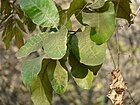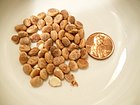Note: This is a project under development. The articles on this wiki are just being initiated and broadly incomplete. You can Help creating new pages.
Difference between revisions of "Buchanania cochinchinensis - Priyala"
(→Common names) |
(→Identification) |
||
| Line 37: | Line 37: | ||
==Identification== | ==Identification== | ||
===Leaf=== | ===Leaf=== | ||
| − | {{Leaf|Simple| | + | {{Leaf|Simple|Alternate|Petiole 12-22 mm, stout, glabrous.}}<ref name="Leaf"/> |
===Flower=== | ===Flower=== | ||
| − | {{Flower|Bisexual|Terminal and axillary panicles|Greenish white|5|calyx lobes 5, persistent | + | {{Flower|Bisexual|Terminal and axillary panicles|Greenish white|5|calyx lobes 5, persistent.}} |
===Fruit=== | ===Fruit=== | ||
| − | {{Fruit|A drupe|10-13 x 8 mm| | + | {{Fruit|A drupe|10-13 x 8 mm|Oblong, laterally compressed, black; stone hard, 2 valved; seed one.||}} |
===Other features=== | ===Other features=== | ||
Revision as of 16:23, 6 April 2020
Priyala is a moderate sized tree. The fruits have a sweet and sour taste and the kernels called chironji have a rich almond like flavour, which are also used in making sweets.
Contents
- 1 Uses
- 2 Parts Used
- 3 Chemical Composition
- 4 Common names
- 5 Properties
- 6 Habit
- 7 Identification
- 8 List of Ayurvedic medicine in which the herb is used
- 9 Where to get the saplings
- 10 Mode of Propagation
- 11 How to plant/cultivate
- 12 Commonly seen growing in areas
- 13 Photo Gallery
- 14 References
- 15 External Links
Uses
Gastritis, Burning sensation, Fever, Aphrodisiac, Excessive thirst. [1]
Parts Used
Chemical Composition
The oil is a promising source of palmitic and oleic acids. Kernel lipids (65.6%), comprised mainly of neutral lipids (90.4%), consist mostly of triacylglycerol (82.2%), freefatty acids (7.8%) and small amount of diacylglycerols, monoacylglycerols and sterols. [2]
Common names
| Language | Common name |
|---|---|
| Kannada | Murkalu, Kolemaavu |
| Hindi | Char, Charoli, Chironji, |
| Malayalam | Cheru, Kalamavu, Moongapezhu, Mungaperlu, Munnalperu |
| Tamil | Cara paruppu, Kattu-ma, Saraiparuppu |
| Telugu | Chaara, Charumaamidi, Chinna morli, Sarapappu |
| Marathi | NA |
| Gujarathi | NA |
| Punjabi | NA |
| Kashmiri | NA |
| Sanskrit | Kharaskandha, Rajadana, Bahulavalkala, Priyala, Chara |
| English | Cudappah almond |
Properties
Reference: Dravya - Substance, Rasa - Taste, Guna - Qualities, Veerya - Potency, Vipaka - Post-digesion effect, Karma - Pharmacological activity, Prabhava - Therepeutics.
Dravya
Rasa
Madhura (Sweet)
Guna
Snigdha (Oily), Guru (Heavy)
Veerya
Sheeta (cold)
Vipaka
Karma
Pitta, vata
Prabhava
Habit
Identification
Leaf
| Kind | Shape | Feature |
|---|---|---|
| Simple | Alternate | Petiole 12-22 mm, stout, glabrous. |
Flower
| Type | Size | Color and composition | Stamen | More information |
|---|---|---|---|---|
| Bisexual | Terminal and axillary panicles | Greenish white | 5 | calyx lobes 5, persistent. |
Fruit
| Type | Size | Mass | Appearance | Seeds | More information |
|---|---|---|---|---|---|
| A drupe | 10-13 x 8 mm | Oblong, laterally compressed, black; stone hard, 2 valved; seed one. | {{{6}}} |
Other features
List of Ayurvedic medicine in which the herb is used
Where to get the saplings
Mode of Propagation
How to plant/cultivate
Season to grow
Soil type
Propagation
Commonly seen growing in areas
Photo Gallery
References
External Links
- Ayurvedic Herbs known to be helpful to treat Gastritis
- Ayurvedic Herbs known to be helpful to treat Burning sensation
- Ayurvedic Herbs known to be helpful to treat Fever
- Ayurvedic Herbs known to be helpful to treat Aphrodisiac
- Ayurvedic Herbs known to be helpful to treat Excessive thirst
- Herbs with Fruits used in medicine
- Herbs with Seed kernel used in medicine
- Herbs with Bark used in medicine
- Herbs with common name in Kannada
- Herbs with common name in Hindi
- Herbs with common name in Malayalam
- Herbs with common name in Tamil
- Herbs with common name in Telugu
- Herbs with common name in Sanskrit
- Herbs with common name in English
- Habit - Tree
- Index of Plants which can be propagated by Seeds
- Herbs that are commonly seen in the region of Tropical area
- Herbs
- Deccan
- Tree
- Anacardiaceae






